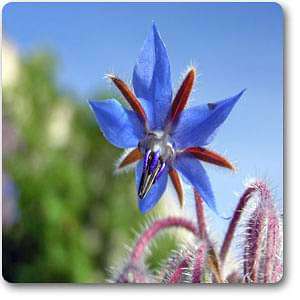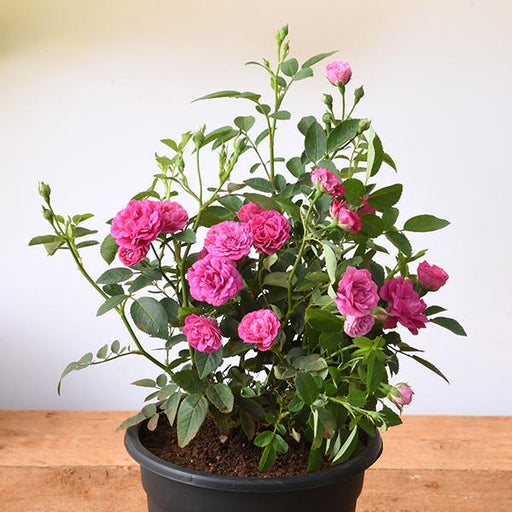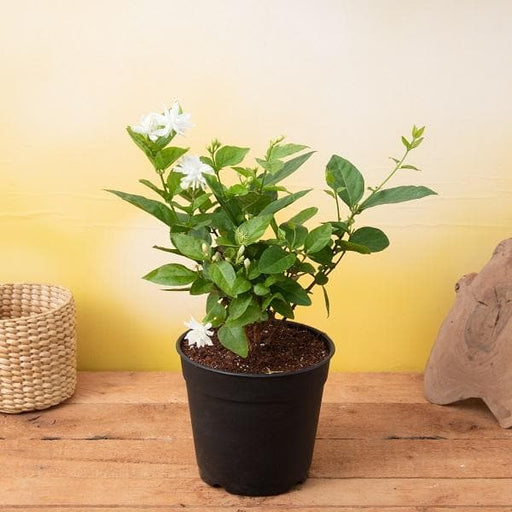
Borago officinalis - Plant
(MRP Inclusive of all taxes)
- Shipping ₹79 for entire order
- Dispatch in 7 days
- Country of origin: India

(MRP Inclusive of all taxes)
 Save 29%
Save 29%
Air Purifier Money Plant with Pot The Air Purifier Money Plant, also known as Pothos or Epipremnum aureum, is a stunning indoor plant that...
View full details
 Save up to 15%
Save up to 15%
Peace Lily, Spathiphyllum - Plant The Peace Lily, scientifically known as Spathiphyllum, is a stunning houseplant celebrated for its elegant white...
View full details
 Save 25%
Save 25%
Jasminum sambac, Mogra, Arabian Jasmine - Plant Jasminum sambac, commonly known as Mogra or Arabian Jasmine, is a fragrant flowering plant...
View full details
 Save 18%
Save 18%
Combo Constituents Includes the Parijat Tree (Night-Flowering Jasmine), a culturally significant plant with fragrant flowers. Description The Pari...
View full details
 Save 25%
Save 25%
Miniature Rose, Button Rose (Any Color) - Plant The Miniature Rose, also known as the Button Rose, is a charming and compact flowering plant that ...
View full details Save 25%
Save 25%
Damascus Rose, Scented Rose (Any Color) - Plant The Damascus Rose, also known as Rosa damascena, is a timeless symbol of beauty and romanc...
View full details
 Save 17%
Save 17%
Beautiful Fragrant Mogra, Arabian Jasmine Plant with Pot The Beautiful Fragrant Mogra, also known as Arabian Jasmine (Jasminum sambac), is...
View full details Save 15%
Save 15%
Pack of Vermicompost and Neem Cake for House Plants Transform your indoor garden with our premium Pack of Vermicompost and Neem Cake, spec...
View full details
Pack of Plant Growth and Flower Boosters Unlock the full potential of your garden with our Pack of Plant Growth and Flower Boosters! This ...
View full details Save 38%
Save 38%
Combo of Jeevamrut and Neem Raksha for Easy Growth and Protection of Houseplants Transform your indoor garden with our exclusive combo of ...
View full details Save 22%
Save 22%
Plant Nutrients Kit (Pack of 16) for a Healthy Garden Transform your garden into a lush paradise with our Plant Nutrients Kit, featuring 1...
View full details Save 16%
Save 16%
Combo of Top Plant Fertilizers Elevate your gardening game with our exclusive Combo of Top Plant Fertilizers, featuring two bags of premiu...
View full details Save 24%
Save 24%
Pack of 4 Additives to Make Soil Healthy and Nutrient Rich Transform your garden into a thriving ecosystem with our Pack of 4 Additives de...
View full details Save 30%
Save 30%
Transform your gardening experience with our premium Combo of Perlite and Vermiculite. This unique blend is designed to enhance soil aeration and ...
View full details Save 27%
Save 27%
Combo of 2 Vermicompost and Cocopeat - Enrich Your Soil Naturally! Transform your garden into a thriving ecosystem with our Combo of 2 Ver...
View full details
 Save 35%
Save 35%
Best 6 Plants for Perfect Indoor Garden Transform your living space into a lush oasis with our curated collection of the Best 6 Plants for a...
View full details
 Save up to 50%
Save up to 50%
Mini Succulent Garden Pack Transform your space with our Mini Succulent Garden Pack, featuring a delightful collection of 4 any variety beautiful s...
View full details
 Save 30%
Save 30%
5 Best Fragrant Plants Transform your garden or indoor space into a fragrant paradise with our curated selection of the 5 Best Fragrant Plants. Th...
View full details
 Save 24%
Save 24%
Set of 2 Bonsai Looking Grafted Adeniums Transform your indoor or outdoor space with our exquisite Set of 2 Bonsai Looking Grafted Adenium...
View full details Save 45%
Save 45%
Top 4 Die Hard Succulents Pack Transform your indoor or outdoor space with our Top 4 Die Hard Succulents Pack, featuring a curated selecti...
View full details
 Save 30%
Save 30%
5 Best Indoor Plants Pack Transform your living space into a lush oasis with our '5 Best Indoor Plants Pack.' This carefully curated collection fe...
View full details
 Save 25%
Save 25%
Set of 4 Evergreen Air Purifier Plant Pack Transform your indoor space into a lush, green oasis with our Set of 4 Evergreen Air Purifier Pla...
View full details| SrNo | Item Name |
|---|---|
| 1 | Borago officinalis - Plant |
Borago officinalis, commonly known as borage, is a striking herbaceous plant renowned for its vibrant blue star-shaped flowers and lush green foliage. Native to the Mediterranean region, this hardy annual is not only a visual delight but also a powerhouse of nutrients, making it a favorite among herbalists and gardeners alike. Borage is often used in culinary dishes, herbal remedies, and as a companion plant in gardens.
What makes borage special is its rich content of gamma-linolenic acid (GLA), an essential fatty acid that supports skin health and reduces inflammation. Additionally, borage flowers are edible and can be used to enhance salads, cocktails, and desserts, adding a unique flavor and aesthetic appeal. Its ability to attract pollinators makes it an invaluable addition to any garden ecosystem.
One of the standout features of Borago officinalis is its ability to thrive in poor soil conditions while providing a habitat for beneficial insects. This makes it an excellent choice for organic gardening and sustainable practices. Furthermore, borage is known for its medicinal properties, including its use in traditional herbal medicine for treating respiratory issues and skin ailments.
Borago officinalis plays a significant role in promoting biodiversity in gardens. Its flowers attract a variety of pollinators, which are essential for the health of ecosystems. Additionally, borage is known for its ability to improve soil health by accumulating nutrients, making it a beneficial companion plant for other crops.
If you thought Borago officinalis was just a pretty face, think again! This herb, also known as borage, is a powerhouse of medicinal properties. From soothing inflammation to boosting mood, it’s like the Swiss Army knife of the plant world. Packed with gamma-linolenic acid, it’s a go-to for skin ailments and hormonal balance. So, if you’re feeling a bit under the weather or just need a pick-me-up, borage might just be your new best friend.
Who knew that a plant could be both a garden diva and a culinary superstar? Borago officinalis, with its starry blue flowers, isn’t just for show. Toss those petals into salads for a pop of color and a hint of cucumber flavor. Infuse your drinks with borage for a refreshing twist. It’s like the herb that brings the party to your plate—who wouldn’t want that?
If you’re ready to roll up your sleeves and get your hands dirty, Borago officinalis is the plant for you! This herb thrives in well-drained soil and loves a sunny spot, making it the diva of the garden. It’s drought-tolerant, so you can forget about those daily watering sessions. Just plant it, sit back, and watch it flourish like the star it is.
Let’s talk nutrition! Borago officinalis is not just a pretty plant; it’s also a nutritional powerhouse. Rich in vitamins A and C, along with essential fatty acids, it’s like a multivitamin in leafy form. Adding borage to your diet can help support your immune system and keep your skin glowing. Who knew being healthy could look so good?
Step back in time and discover the historical significance of Borago officinalis. This herb has been cherished since ancient times, used by the Romans to boost courage and by medieval knights for its restorative properties. It’s like the original superhero of the plant kingdom, saving the day one leaf at a time.
Who needs chemical pesticides when you have Borago officinalis? This herb is not just a beauty; it’s also a pest repellent! Its strong aroma can deter pesky insects, making it a natural ally in your garden. Plant it alongside your veggies, and let borage do the dirty work while you sip lemonade and enjoy the view.
If you’re into gardening, you’ll love the concept of companion planting, and Borago officinalis is the ultimate wingman. This herb pairs well with tomatoes and strawberries, enhancing their growth and flavor. It’s like the best friend who always brings out the best in you—plant it nearby, and watch your garden thrive!
Get ready to elevate your self-care game with Borago officinalis essential oil. Extracted from the leaves and flowers, this oil is known for its calming properties. A few drops in your diffuser can turn your home into a serene oasis. It’s like a spa day in a bottle—who wouldn’t want that?
Ready to reap the rewards of your borage garden? Harvesting Borago officinalis is as easy as pie! Snip the leaves and flowers when they’re young for the best flavor. Just remember, the more you harvest, the more it grows—like a plant that just can’t get enough attention.
Don’t let those beautiful borage flowers go to waste! Drying them is a fantastic way to preserve their beauty and benefits. Use them in herbal teas or as a colorful garnish for your culinary creations. It’s like giving your dishes a touch of elegance—who knew dried flowers could be so chic?
Sip your way to wellness with Borago officinalis tea! This delightful brew is not only refreshing but also packed with health benefits. It can help with digestion, reduce stress, and even promote better sleep. It’s like a warm hug in a cup—perfect for those cozy evenings when you just want to unwind.
Borago officinalis, commonly known as borage, is a delightful herb with star-shaped blue flowers. It’s like nature’s confetti, adding a pop of color to gardens and salads alike. This plant is not just a pretty face; it’s packed with nutrients and has been used for centuries in herbal medicine. Who knew beauty could be so beneficial
Borage loves to party in sunny spots, thriving in well-drained soil. It’s a Mediterranean native, so think warm, dry climates. However, it’s not picky; it can also adapt to cooler regions. Just give it some sunlight and watch it flourish like a diva on stage, demanding attention with its vibrant blooms.
Borage is a multitasker! It’s used in culinary dishes, herbal remedies, and even cosmetics. The leaves can be tossed in salads, while the flowers make a stunning garnish. Plus, it’s known for its anti-inflammatory properties. Who knew a plant could be a chef, healer, and beauty guru all at once
Absolutely! Borage leaves and flowers are edible and can add a refreshing cucumber-like flavor to your dishes. Toss them in salads, freeze the flowers in ice cubes, or steep them in tea. Just remember, moderation is key; too much of a good thing can turn your culinary masterpiece into a botanical blunder.
Growing borage is as easy as pie! Just scatter the seeds in well-drained soil, give them some sunlight, and water them occasionally. They’ll sprout like eager children on a playground. Once established, they’re drought-tolerant and self-seeding, so you might find yourself with a borage party year after year!
Borage is like a health superhero! It’s rich in gamma-linolenic acid (GLA), which can help with inflammation and skin health. It’s also known to support mood and hormonal balance. So, if you’re feeling a bit off, a little borage might just be the herbal hug you need to feel fabulous again.
Yes, indeed! Borage is a pollinator magnet, attracting bees and butterflies like a floral disco ball. Its vibrant blue flowers are irresistible to these little winged friends, making it a fantastic addition to any garden. Plant borage, and you’ll have a buzzing party of pollinators, ensuring your garden is alive and thriving.
Fear not! Borage is not considered invasive, but it can spread if left unchecked. It self-seeds readily, so if you want to keep it in check, just deadhead the flowers before they go to seed. Think of it as a friendly neighbor who occasionally overstays their welcome but is easy to manage.
Harvesting borage is a breeze! Snip the leaves and flowers as needed, preferably in the morning when they’re at their freshest. Just be sure to leave some behind for the plant to continue growing. It’s like taking a slice of cake without demolishing the whole thing—everyone gets to enjoy!
Yes, borage can be a fabulous indoor plant! Just ensure it gets plenty of sunlight and a pot with good drainage. It might not be as big as its outdoor counterparts, but it’ll still bring a touch of nature indoors. Plus, you’ll have fresh borage at your fingertips for culinary adventures!
Borage is surprisingly pest-resistant, but it can attract a few uninvited guests like aphids and slugs. If you spot them, don’t panic! A gentle spray of water or a sprinkle of diatomaceous earth can send them packing. Borage is tough; it can handle a little pest drama without losing its charm.
While borage is generally safe for humans, it’s best to keep it away from pets. Some sources suggest it may not be suitable for cats and dogs in large amounts. So, if your furry friend decides to munch on your borage, just keep an eye on them. Better safe than sorry in the pet world!